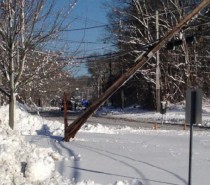
by Brianna Crandall — December 10, 2014—As snow recently blanketed the northern United States and many areas battled freezing temperatures, the Insurance Institute for Business & Home Safety (IBHS), a national research and communications organization, offered severe winter weather guidance for home and business owners to reduce their property damage risks.
“With this early onset of severe winter weather, please take the time to understand the various winter weather alerts and stay tuned to the National Weather Service advisories,” urged Julie Rochman, IBHS president and CEO. “Also, we encourage residents and business owners to take steps now and use IBHS’ recommendations to protect your home or business today and to be prepared because it could be a very long winter season.”
IBHS provides the following guidance below, along with additional winter weather resources available on the organization’s Web site, including Getting Your Business Ready for Severe Winter Weather.
IBHS FREEZING WEATHER GUIDANCE TO REDUCE PROPERTY DAMAGE
Stay Safe and Warm
Alternative heating is a great way to stay warm during the cold weather, but its use comes with risks. Check IBHS’ alternative heating advice before selecting, installing, or using an alternative heating source.
Build a Plan for a Power Outage
Heavy snow and high winds are a recipe for widespread power outages. It is important to prepare a plan now before a possible outage. IBHS offers information on how to use alternative heat sources and generators safely during a power outage on its Build a Plan for a Power Outage site.
Prevent Roof Collapse
Significant snowfall can put a strain on a roof that could cause significant damage and even potential collapse. Unless a roof structure is damaged or decayed, most residential roofs should be able to support 20 pounds (lbs.) of snow per square foot of roof space before they become stressed. The IBHS Snow Roof Risks infographic helps home and building owners determine how much the snow/ice on a roof weighs.
Prevent Ice Dams
During freezing weather, heat from a home or business can escape through the roof and melt snow on the roof. The snowmelt can then trickle down to the roof’s edge and refreeze, creating an ice dam that leaves additional snowmelt with no place to go but possibly under the roof. IBHS offers guidance to help homeowners and smaller building owners prevent costly ice dams below and online.
- Keep all drains, scuppers, gutters, and downspouts free of debris and vegetation that may restrict proper flow.
- Remove or relocate heat sources that are installed in open attic areas directly under the roof, such as an attic.
- Insulate light fixtures in the ceiling below an unheated attic space.
- If there are penetrations into the attic, such as vents, seal and insulate them so that daylight cannot be seen and airflow is minimal.
- If ice dams form around the drains, connect heating cables to the drains to prevent ice buildup. Heating cables can also be placed on the roof, connecting them to the drainage system so a path is created for the melting ice to follow.
Prevent Frozen Pipes
Frozen pipes are one of the biggest risks of property damage when the temperature drops. In fact, a burst pipe can result in more than $5,000 in water damage, according to IBHS research. Check out IBHS’ frozen pipes infographic, and prevent a costly water damage bill caused by frozen pipes by using the following guidance:
- Provide a reliable back-up power source to ensure continuous power to the building.
- Insulate all attic penetrations.
- Ensure proper seals on all doors and windows.
- Seal all wall cracks and penetrations, including domestic and fire protection lines, electrical conduit, other utility service lines, etc.
- Install insulation and/or heat trace tape with a reliable power source on various wet sprinkler system piping. This includes main lines coming up from underground passing through a wall as well as sprinkler branch lines.
- Place a monitored automatic excess flow switch on the main incoming domestic water line to provide early detection of a broken pipe or valve when the space is unoccupied.
Install Weather Stripping and Seals
Prevent freezing temperatures from entering a home or business by installing weather stripping and seals. This offers two major benefits — it will keep severe winter weather out of a home or business, and sealing a property shut also greatly increases energy efficiency by limiting drafts and reducing the amount of cold air that enters. Inspect the following areas for leaks to determine possible areas to seal:
- Windows and doors
- Vents and fans
- Plumbing
- Air conditioners
- Electrical and gas lines
- Mail chutes
IBHS is an independent, nonprofit, scientific research and communications organization supported by the property insurance industry. The organization works to reduce the social and economic effects of natural disasters and other risks on residential and commercial property by conducting building science research and advocating improved construction, maintenance and preparedness practices.




